Helping Pollinators While Beautifying Your Landscape
Of late when we hear anything about bees, it’s usually scary press. We hear that their colonies are collapsing and that they’re feeling pressure from pesticides, diseases, habitat destruction and insects that attack their hives. When we hear about ways our world is changing, it can seem insurmountable. It can be hard to listen to the bad news because it keeps coming and we may feel that we can’t do anything about these large-scale shifts. In spite this, believe we can help through some simple key actions.
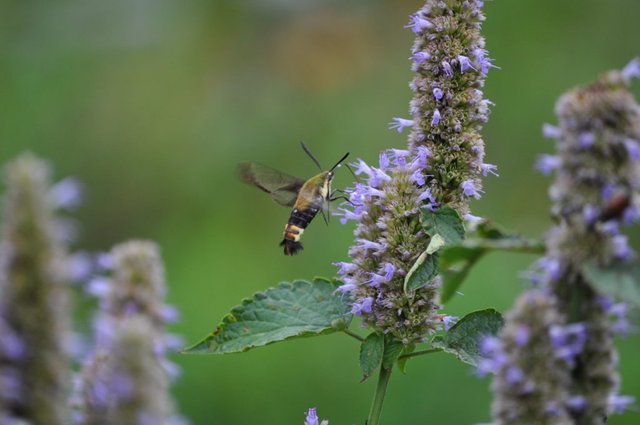
Snowberry Clearwing on the Anise Hyssop
When it comes to bees, especially honeybees, our wellbeing depends on their survival and indeed the ecosystem services they provide for us, pollination being chief. We have a long-term relationship with bees as they provide much of the pollination needed to get our food turned from a flower into a fruit, for example. In fact, a study done in California found that “native bee species pollinate between 35 and 39 percent of California’s crops and contribute at least $1 billion to its agricultural economy.” For economic reasons alone this is certainly an issue important to humans! Regardless, we wont survive very long in a world without pollinators.
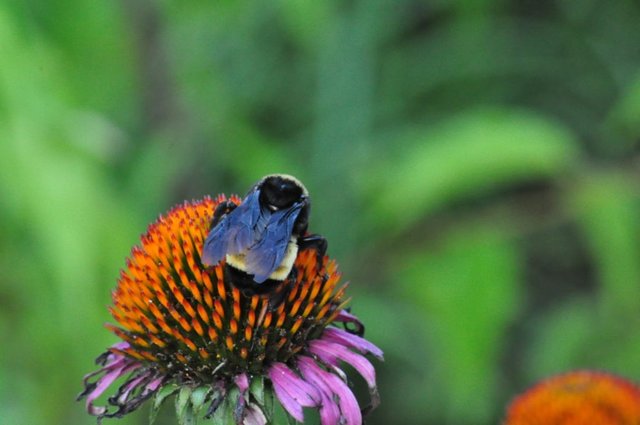
Bumble bee on Coneflower
To help Bringbackthepollinators.org suggests:
- Grow a variety of pollinator-friendly flowers (I’ll list some awesome options below.)
- Protect and provide bee nest sites and caterpillar host plants.
- Avoid using pesticides, especially insecticides and
- Spread the word
Pesticides are one of the biggest threats facing bees (and insects) and they often live in the environment long after they’re sprayed, meaning that we aren’t even completely aware of the negative effects that continue to have ripples for years to come. In order to be an ally to our pollinators, stop using them! You can transition part of your yard to a pollinator habitat instead and you won’t have to worry about spraying.
Establishing a pollinator habitat
Studies have shown that wildflower or native plant “strips” planted at the edges of lawns or farm fields greatly benefit pollinators and they can increase pollination in nearby crops (a boon to farmers). This can be as easy as buying one or two plants a year at a native plant sale and putting them into your existing landscaping or you could dig up a portion of your yard and dedicate it to the pollinators. You’ll also find the added benefits of beauty and delight that come from watching bees and insects!
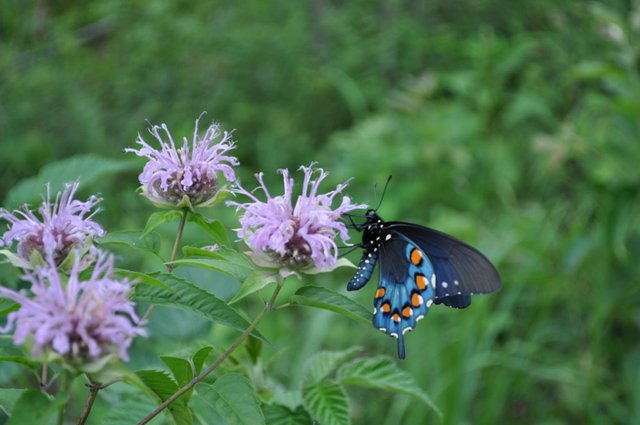
Butterfly enjoying Bee Balm
Some species that bees especially love that I love to witness around our homestead include:
Wild Bergamot: aka Bee Balm, there are many native species of this plant and it also comes in a diverse array of bright flowers. It’s easy to grow and comes back year after year. The leaves and flowers are also a great medicinal tea.
Anise Hyssop: Neither a true anise or hyssop, this plant is a stunning plant in the garden that blooms nearly all season long. Out of all of the plants in my garden, this one had the most pollinators on it at all times. It is also easy to grow, comes back each year and produces a delicious medicinal tea from the leaves.
Purple Coneflower: another native that is very well known. Echinacea is a drought hardy, easy to grow (it spreads!) beautiful medicinal plant that is a boon to pollinators. Often I would spy bumble bees on our coneflower.
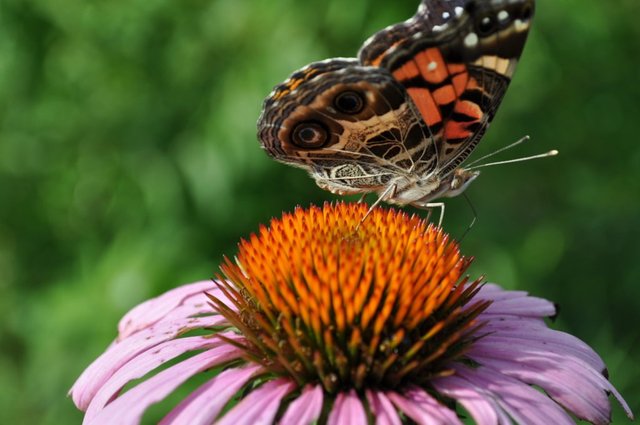
Butterfly eyeing me from the Echinacea
Mints: These are easy to grow useful plants that also spread (you can grow them in a pot by the house as well.) Pollinators love the mints and, again, they produce a wonderful tea for humans (a theme!).
Clovers: This is as easy as taking a trip to the local feedstore. We get bulk clover seeds and sow them all over the homestead. They not only provide a living mulch and attractive nitrogen-fixing groundcover, but bees, butterflies, beetles & flies love them. They’ll come back year after year and you can even substitute some of the grass in your yard with them. Their dried flowers provide a healthy nourishing tea.
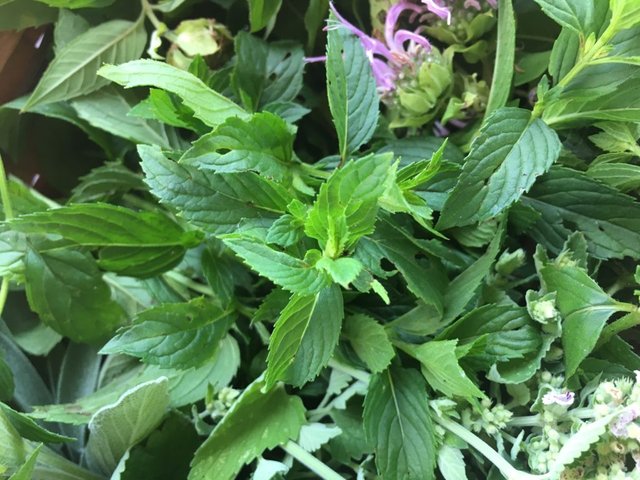
An assortment of mints taken from around the homestead. Great for pollinators and tea.
These are some of our favorite and easiest to grow suggestions for starting off your pollinator habitat. To find out more, you can google “Beneficial Pollinator Plants” and find more suggestions! While beautifying your space, you’re also helping our bees and other winged ones! A win-win!
Sources:
https://xerces.org/pollinator-conservation/plant-lists/Posted from my blog with SteemPress : http://www.ozarkmountainjewel.com/2019/04/25/helping-pollinators-while-beautifying-your-landscape/
Amazing photo.
Posted using Partiko Android
Love those cone flowers and bee balm :) I'm growing Pentas for both the bees and the butterflies! :) Can't wait to see your butterfies!! oxox
Borage and sacred basil are great options also.
Posted using Partiko Android
You've been visited by @porters from Homesteaders Co-op. Thanks for passing on this message about helping our valuable bees/pollinators which in turn will actually be helping us! --- A community marketplace of ethical, handmade and sustainable products available for STEEM, SBD (and USD): https://homesteaderscoop.com follow: @homesteaderscoop
A community marketplace of ethical, handmade and sustainable products available for STEEM, SBD (and USD): https://homesteaderscoop.com follow: @homesteaderscoop
An important post in my book. Spread 're word indeed. More flowers for bees. Mine love oregano, thyme, calendula, fennel flowers, comfrey.
In Heath, MA the wild blueberry farm we pick at each year has gone to great lengths to set up habitat for many kinds of pollinators. It's very cool looking for all the areas and housing items.
Here, I just make sure I have plenty of different flowering plants in every garden. We used to have honey bees here but haven't seen them in years. But there are lots of other kinds of pollinators in their place.
Hi @mountainjewel!
Your post was upvoted by @steem-ua, new Steem dApp, using UserAuthority for algorithmic post curation!
Your UA account score is currently 4.846 which ranks you at #1388 across all Steem accounts.
Your rank has improved 14 places in the last three days (old rank 1402).
In our last Algorithmic Curation Round, consisting of 174 contributions, your post is ranked at #37.
Evaluation of your UA score:
Feel free to join our @steem-ua Discord server
You’ve been visited by @walkerland on behalf of Natural Medicine!
This is such an important message and the photographs are BEAUTIFUL! Have you seen pollinator hotels before? I've been wanting to make one for ages just as extra insurance that they all have somewhere safe to live. Sometimes I'll be gardening and lift up some straw to find bees sleeping and I'll carefully place the straw back and leave them. Until I moved here I didn't actually know that some bees sleep in the ground.
We have a large pasture area that we'll be tilling up this year and turning into new gardens, with plenty of wild flower ground cover and whatever else we can manage. It is going to be quite a job. My husband raised pigs our first year and he's given me the area (wooho) because we really aren't confined animal type people. He just needed the experience to learn that. I feel like I've won the lottery because it's all fenced in and the pig shelter is beautiful - perfect for sheltering the beehives.
The honey bee house will be right in the center (no honey bees yet, hoping this is the year). It is such fun to plan out a garden with pollinators in mind plus, often the plants they gravitate towards are good for our health as well.
Loved your post! :)
50SPII100SPII200II500SPII1000SP
Consider supporting Natural Medicine through continued use of the #naturalmedicine tag, or delegating any amount through clicking the amounts above. We love to support those on a healing journey or writing about natural health wisdoms. Come join us on Discord if you're not already there! We'd love to have you.
What an amazing post. This is exactly the post I needed to read. I was at a podium discussion at the local uni here last year and they were talking about almost 70% of all pollinating insects going extinct since the 80s in Germany alone and debating about the causes. Switzerland also had subsidies for farmers on pesticides and use almost double the amount per hectare than Germany. Pharmaceutical companies must be happy to fill their pockets from tax payers money here. No one really addresses the Colony Collapse Disorder of honeybees caused by mobile radiation. Magnetic forces affect us all and I am really happy someone is at least pointing out a way to create a habitat for beneficial insects. I got some lavender which I will plant in the coming days. Temperatures just dropped drastically, so I will plant them on the last day of rain in wet soil. So exited to take pictures of pollinators soon. Thank you for your great post!
awesome! glad to hear you're already busy planting :) lavender is such a great choice. yes, so many are still in the dark about this and our governments owned by the corporations aren't helping or making any big moves. i read a study yesterday as well that said that even in neighborhoods, if everyone planted a little patch for the pollinators, it would add up in a significant way.
here it is: https://xerces.org/2017/02/07/planting-for-pollinators-in-your-backyard-and-beyond/
very inspiring! glad the message came at the right time <3
Thank you so much for participating in the Partiko Delegation Plan Round 1! We really appreciate your support! As part of the delegation benefits, we just gave you a 3.00% upvote! Together, let’s change the world!